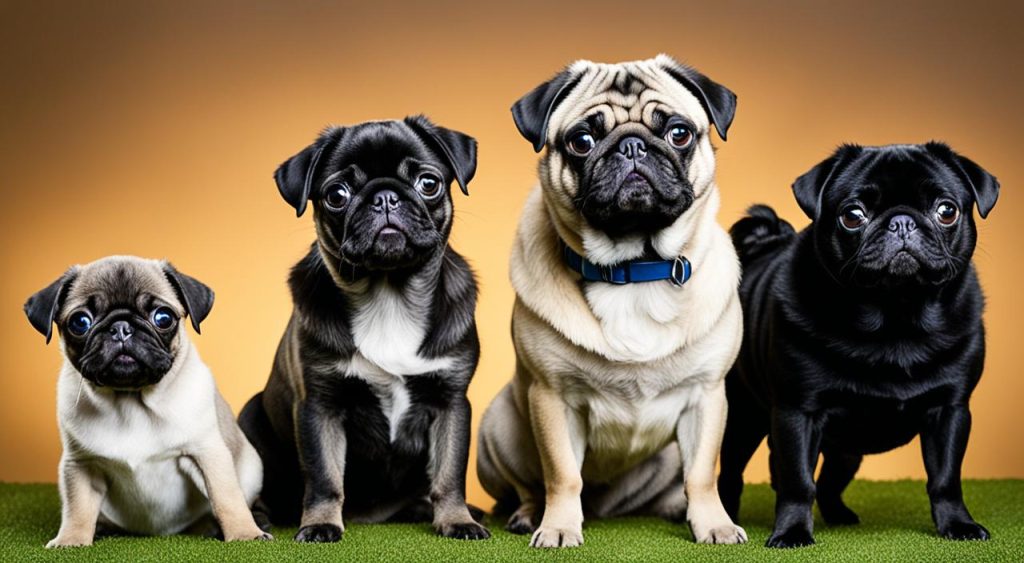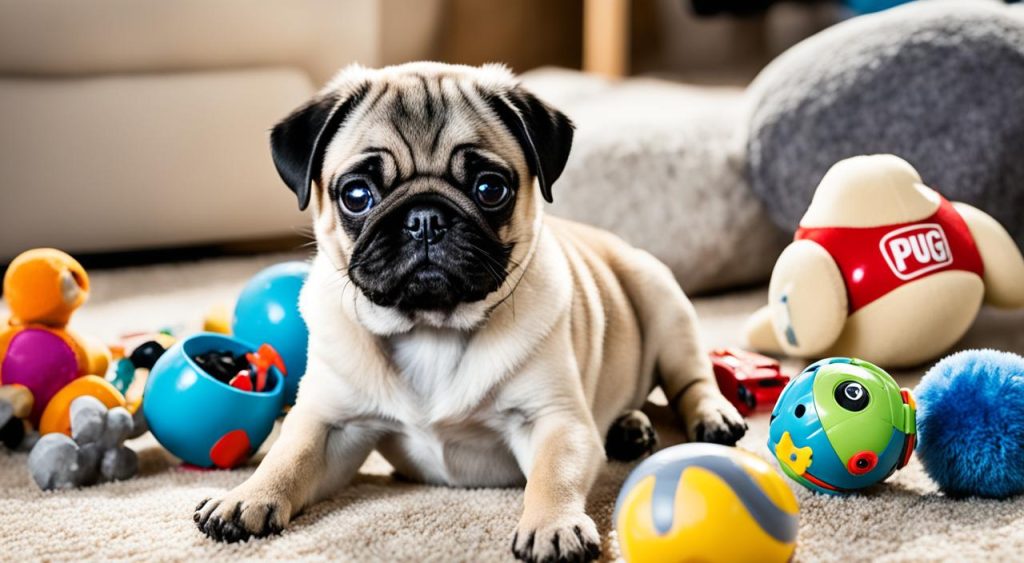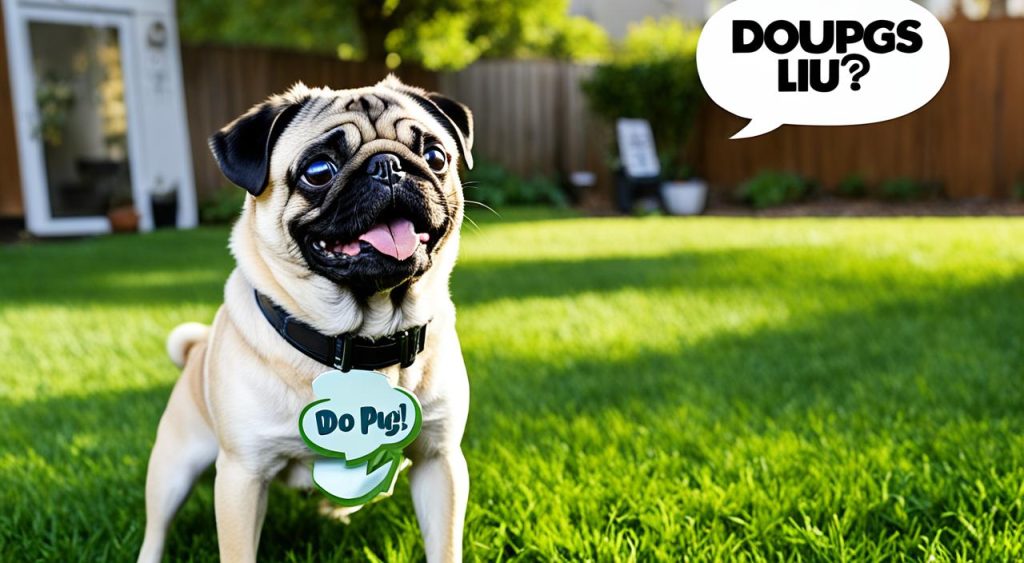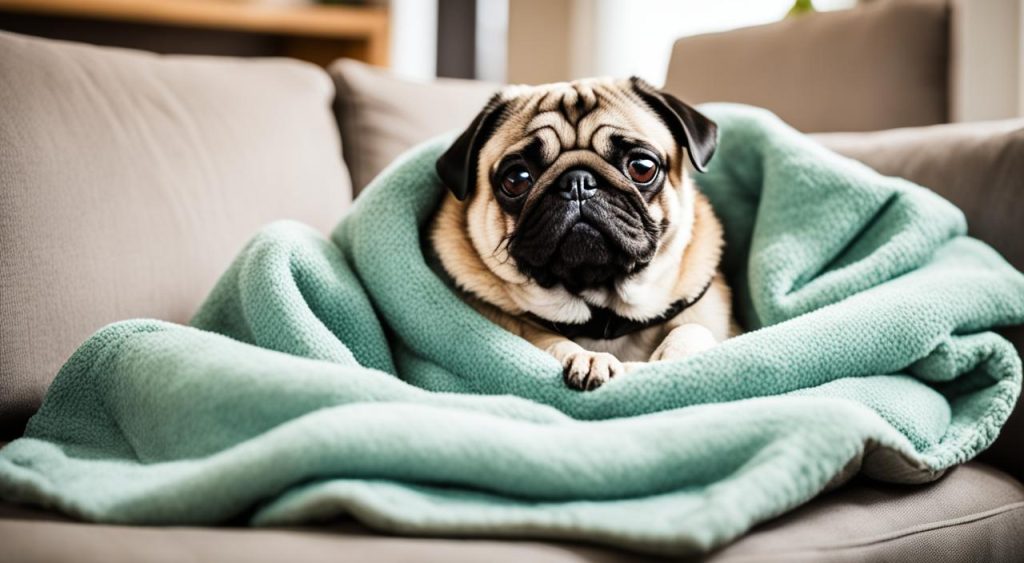Pugs are known for their adorable wrinkled faces and playful personalities, but did you know that they also come in a variety of rare and unique colors? From the classic black and fawn Pugs recognized by the American Kennel Club to lesser-seen variations such as white, brindle, and silver, each Pug color has its own distinct characteristics that make it truly special.
While fawn is the most common color among Pugs, there are several other rare Pug variations that are worth exploring. Whether you’re interested in discovering the least common Pug colorations, the unique Pug characteristics associated with different coat patterns, or the least seen Pug traits and markings, this article will take you on a journey through the world of the rarest Pug attributes.
Key Takeaways:
- Pugs come in a variety of rare colors, including white, brindle, and silver
- Each Pug color has its own distinct characteristics and traits
- Fawn is the most common Pug color, followed by black
- White Pugs may have health concerns related to albinism
- Brindle, silver, and pink are among the many other rare Pug colors
Fawn Pugs: The Most Common Pug Color
Fawn is the most common color among Pugs. Fawn Pugs have a tan coat with a black muzzle and brown eyes. The fawn color can vary in shade, with some Pugs having a lighter or darker coat.
Fawn Pugs are known for their clownish behavior, lovable personalities, and tendency to snort and fart. They are often seen in media and are considered the “typical” Pug.
When it comes to fawn Pug traits, these adorable dogs are known for their playful nature, making them great companions for families and individuals alike. They thrive on attention and love being the center of attention. Their friendly and affectionate personalities make them popular pets and are sure to put a smile on your face.
The fawn Pug coat color adds to their charm and gives them a timeless and classic look. Their black muzzle and expressive brown eyes beautifully complement their fawn coat, making them irresistibly cute.
If you’re considering getting a fawn Pug, be prepared for their mischievous antics and their ability to steal your heart. Their clownish behavior can keep you entertained for hours, and their affectionate nature will make them a beloved member of your family.
Black Pugs: Shedding Less and More Energetic
Black Pugs have a dominant gene that gives them a stunning solid black coat. Unlike their fawn counterparts, black Pugs shed less frequently due to their single coat. This means less hair to deal with, making them a popular choice for those seeking a Pug with minimal shedding.
Not only are black Pugs known for their beautiful black color, but they also possess an energetic nature that sets them apart from other Pug colors. They are often more active and lively, making them great companions for individuals who enjoy an energetic and playful pet.
Whether it’s a game of fetch or a brisk walk in the park, black Pugs are always up for fun and adventure. Their high energy levels make them ideal for families with active lifestyles or those looking for a furry friend to keep them on their toes.
Black Pugs, with their striking coat color and lively disposition, bring an extra level of excitement and energy to your life. Their unique traits and personality make them a favorite among Pug enthusiasts who crave an energetic companion.
White Pugs: Rare and Beautiful
White Pugs are a rare and highly sought-after variation of the Pug breed. Their stunning white coat color sets them apart and adds to their unique charm. While white Pugs are not as common as their fawn or black counterparts, they have become increasingly popular among Pug enthusiasts.
It’s important to note that not all white Pugs are considered albino. Some white Pugs have a leucistic gene that gives them their light-colored coat. However, there are white Pugs that do have a form of albinism, which can carry certain health concerns.
Albinism in White Pugs and Health Concerns
“Some white Pugs may have a form of albinism, which can result in health issues. These include sensitivity to the sun and an increased risk of developing skin cancer. It’s crucial to protect white Pugs with albinism from prolonged sun exposure and provide them with proper skin care.”
If you have a white Pug with albinism, it’s important to prioritize their well-being and take necessary precautions to keep them safe from the sun’s harmful rays. This may involve limiting their outdoor time during peak sun hours, applying pet-friendly sunscreen, and providing them with adequate shade.
However, it’s essential to remember that not all white Pugs possess the albinism gene. Many white Pugs are perfectly healthy and do not face any specific health concerns related to their coat color.
White Pugs, regardless of albinism or leucism, have the same lovable and friendly personality as other Pugs. They are known for their goofy antics, affectionate nature, and loyalty to their families.
Whether you prefer a standard fawn Pug or are captivated by the beauty of a white Pug, responsible breeding and proper care are key to ensuring the health and well-being of these delightful companions.
Brindle, Silver, Apricot, Pink, and Other Rare Pug Colors
In addition to the common fawn, black, and white Pugs, there are several other rare Pug colors that add a touch of uniqueness to this beloved breed. These rare Pug colors are truly a sight to behold, each with its own captivating characteristics and attributes. Let’s explore these exotic Pug colors together!
Brindle Pugs: A Striking Coat Pattern
Brindle Pugs stand out with their distinct coat pattern featuring dark stripes on a lighter background. Their stripes can vary in depth and can create a mesmerizing and eye-catching appearance. This unique coat pattern adds an extra touch of elegance and sophistication to these already charming dogs.
Silver Pugs: Light as a Feather
Silver Pugs have a light gray coat and are considered one of the lightest Pug colors. Their ethereal appearance is often admired, and their coat color enhances their adorable features. Silver Pugs are truly a rare gem, captivating anyone who lays their eyes on them.
Apricot Pugs: Warm and Radiant
Apricot Pugs boast a warm orange tinge to their coat, resembling the color of a ripe apricot. This rare Pug color exudes a sense of warmth and radiance, making them incredibly charming and appealing. Their vibrant coat color is sure to brighten up your day.
Pink Pugs: An Unforgettable Hue
Pink Pugs, the rarest of them all, are bred with albinism to have a pink appearance. This unique Pug color is truly extraordinary and stands out from the rest. With their captivating pink coat and distinctive features, these Pugs are sure to leave a lasting impression wherever they go.
These rare Pug colors – brindle, silver, apricot, and pink – give us a glimpse into the vast and diverse world of Pug variations. Each color has its own enchanting qualities, setting them apart from the more common Pug colors. Whether you’re drawn to the striking pattern of the brindle Pug, the ethereal beauty of the silver Pug, the warm radiance of the apricot Pug, or the unforgettable hue of the pink Pug, these rare Pug colors are a testament to the incredible diversity within the Pug breed.
Conclusion
Pugs come in a wide array of rare and uncommon colors, each with its own unique characteristics and traits. Whether you prefer the most common fawn Pugs or the rarest brindle, silver, or pink Pugs, there is a Pug color to suit every individual’s taste.
While some colors may have associated health concerns, responsible breeding and proper care can help mitigate any potential issues. It’s important to be aware of these considerations and choose a reputable breeder who prioritizes the health and well-being of their Pugs.
Ultimately, the rarity of a Pug variation is subjective and dependent on personal preference. What matters most is finding a Pug that brings joy, companionship, and unconditional love to your life, regardless of its color. Each Pug, regardless of its coat color, will have the same lovable and unique personality traits that make them such wonderful companions.





